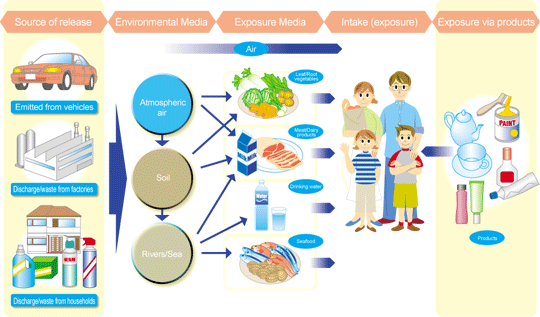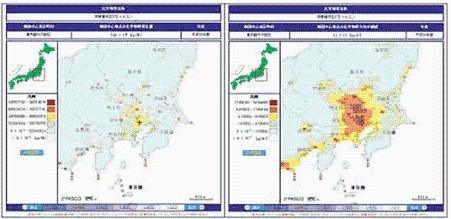Risk Assessment on chemicals-For Better Understanding-6
EHE (Estimated Human Exposure)
What is EHE?
EHE is the estimated exposures at which chemicals have effects on humans,, calculated on the basis of assumptions about respiration, amounts of meals, body weight and so on.
Exposure can be divided by route into “direct exposure” and “indirect exposure.”
“Direct exposure” for example, is a direct intake of chemicals while working etc. at a factory.
“Indirect exposure” means indirect intake of chemicals through their release → being discharged to the environment → breathing the air, drinking the water, eating the foods, etc. → and thus intaking them (exposure). It is also called “exposure via environment.”
*“Indirect exposure” sometimes occurs via products.

The practical exposure level for individuals varies depending on chemicals and the living environment (place of living, foods routinely ingested, and so on).
Not all the chemicals that are contained in the air, drinking water and foods are absorbed, and the absorbed chemical substances do not all affect humans and the living body.
The term “EHI” (Estimated Human Intake) is sometimes used in the same meaning as EHE.
column
*”Initial Risk Assessment Report” under the NEDO Project primarily shows estimates of indirect exposure.
Initial Risk Assessment Report
EHE is obtained by calculating the monitoring data and data on PRTR emission for an assumed case of maximum human exposure in Japan.

Reference information: Map of Toluene sources (left) and Map of ambient Toluene concentrations
Methods for calculation of estimated total exposure at the time of Initial Risk Assessment
The amount of daily intake by five routes listed below are totaled and divided by the human body weight (50 kg) to yield Total Exposure Level in units of mg/kg/day or μg/kg/day.
- 1.Exposure via respiration
Concentration in ambient air x amount of air inhaled (20 m3/day) = exposures - 2.Exposure via drinking water
Concentration in drinking water x amount of water taken (2 L/head/day) = exposures - 3.3)Exposure via foods
Concentration in foods x amount of foods ingested = exposures
If the data on concentration in foods are not available, exposures by intake of fish/shellfish is calculated. - 4.Concentration in fish/shellfish x amount of fish/shellfish ingested (120 g/day) = exposures
- 5.Exposure via other foods (crops, vegetables, fruits, meats, eggs, dairy products)
Exposures are estimated referring to the data collected, study reports etc. carried out by the Ministry of Health, Labour and Welfare. - 6.Exposure via household products
Exposures from each product are estimated with its usage taken into account.
Absorption rate is deemed to be 100% unless specific data on human metabolism etc. are available.
Contact us
- Chemical Management Center, National Institute of Technology and Evaluation
-
Phone number:+81-3-3481-1977
Fax number:+81-3-3481-2900
Address:2-49-10 Nishihara, Shibuya-ku, Tokyo 1510066, Japan MAP
Contact Form